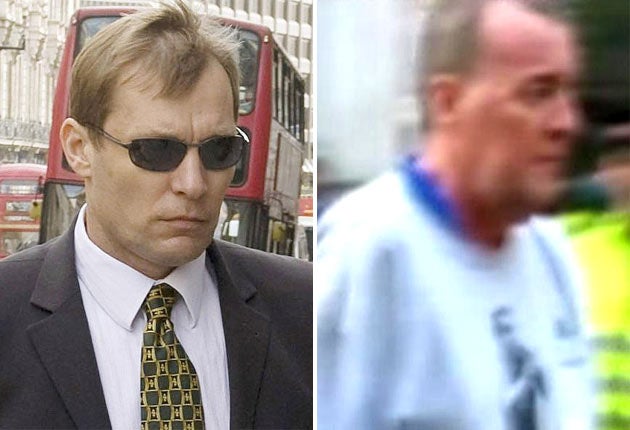PC faces criminal charge over 'unlawful killing' of Tomlinson
Verdict from inquest into death at G20 protests leaves policeman open to prosecution

Police Constable Simon Harwood, the officer who shoved the newspaper seller Ian Tomlinson minutes before he died, is facing disciplinary action and the prospect of a criminal charge after a coroner's jury yesterday returned a verdict of unlawful killing.
Mr Tomlinson collapsed and died minutes after being pushed over and struck with a police baton on the fringe of a demonstration that accompanied the G20 summit in London in April 2009. Footage of homeless man's last minutes showed him to be an ambling figure, wandering past police lines with his hands in his pockets, posing no apparent threat.
But his demeanour angered the police constable who thought he was being "almost defiant". A jury at the end of a five-week inquest ruled that PC Harwood acted "illegally, recklessly and dangerously" in shoving Mr Tomlinson to the ground and used "excessive and unreasonable" force in hitting him with a baton.
PC Harwood, a member of Scotland Yard's territorial support group, was told last July he would not face charges over the death, which Scotland Yard initially attributed to "natural causes". But yesterday the Director of Public Prosecutions, Keir Starmer, promised a "thorough review" of the decision not to prosecute.
The Tomlinson family's solicitor, Jules Carey of Tuckers Solicitors, said: "Today's decision is a huge relief to Mr Tomlinson's family. To many, today's verdict will seem like a statement of the blindingly obvious; however this fails to take account of the significant and many obstacles faced by the family over the last two years to get to this decision. The CPS will now review whether a prosecution will be brought following today's verdict and the way in which the evidence has been clarified during the inquest process."
Mr Tomlinson, 47, was an alcoholic with liver disease who was on his way to a hostel when he shuffled past police lines. His widow, Julia, told the inquest he usually walked with his head bowed and hands in his pockets. "This was partly because he had limited use of one of his hands – an old injury," she said. "But I would also think it [was] because he didn't like to impose himself in a situation and liked to show that he was no bother."
His family told the inquest that despite his alcoholism, he had been a loving father, but drifted away from the family into heavy drinking, possibly because of a difficult childhood in Derbyshire. Mrs Tomlinson said: "I remember feeling he was the best thing that ever happened to me."
A statement released by PC Harwood's solicitors yesterday emphasised that the officer knew nothing of Mr Tomlinson's medical condition when he pushed him. "PC Harwood did not intend, or foresee at the time, that his push would cause Mr Tomlinson to fall over, let alone that it would result in any injury," the statement said.
"PC Harwood gave evidence to the coroner and jury for three days. He did his best to answer truthfully every question he was asked, even when he was told by the coroner that he did not have to," it added.
Scotland Yard's Deputy Assistant Commissioner Rose Fitzpatrick said: "It is a matter of deep regret that the actions of a Metropolitan Police Service officer have been found to have caused the death of a member of the public." She added that misconduct proceedings would be opened against PC Harwood.
Paul King, Mr Tomlinson's stepson, said he and his relatives hoped that the policeman would now face a charge of manslaughter. "After two years, we're really grateful that the inquest process has made a strong statement about how Ian died," he said. "We are grateful to the jury and the coroner and we think the jury finding speaks for itself in the verdict of unlawful killing.
"We hope the DPP will consider what the jury has said in their evidence and what has come out," he added. "We are looking forward to the next stages in the search for justice for Ian. We have been let down for two years, and this is the first bit of hope we have had."
A spokesman for the Crown Prosecution Service said that a review of the case "will take into account all of the evidence now available, including any new evidence that emerged at the inquest, the issues left by the coroner to the jury and the conclusions they reached".
"The review will be conducted as quickly as is compatible with the care and rigour required in a thorough exercise," the spokesman added.
The verdict discredited the findings of Dr Freddy Patel, the pathologist who said Mr Tomlinson died of a heart attack. Two other pathologists attributed his death to internal bleeding. Dr Patel has been sanctioned twice by the General Medical Council and is suspended from the Home Office register of forensic experts.
The two-year legal battle
1 April 2009 Ian Tomlinson collapses and dies during anti-G20 conference protests in London.
4 April 2009 A post-mortem examination finds Mr Tomlinson suffered a heart attack and died of "natural causes".
7 April 2009 Video footage from a passer-by comes to light showing Mr Tomlinson being pushed to the ground by a police officer shortly before his death.
17 April 2009 A second post-mortem examination finds Mr Tomlinson died from an "abdominal haemorrhage".
22 July 2010 The Crown Prosecution Service says PC Harwood will not face charges over Mr Tomlinson's death, provoking outrage.
3 May 2011 The inquest jury rules that Mr Tomlinson posed no threat and was 'unlawfully killed' by PC Harwood.
